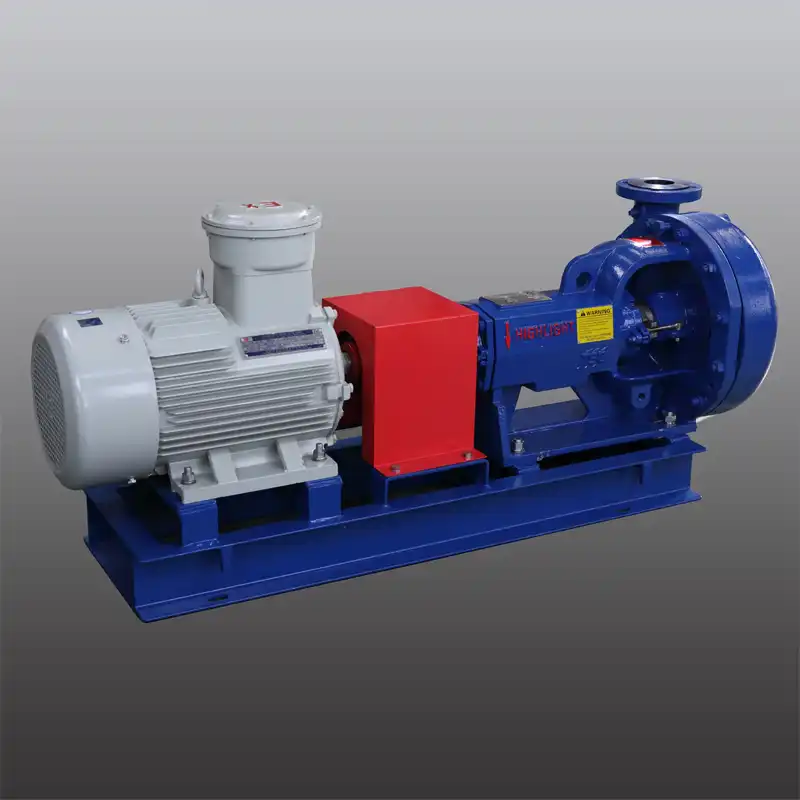Assessing Flow Rate and Pressure Requirements
Understanding your system's flow rate and pressure requirements is fundamental when selecting a centrifugal pump for oil and gas applications. These parameters directly influence the pump's size, power, and overall design.
Determining Optimal Flow Rate
The flow rate, measured in gallons per minute (GPM) or cubic meters per hour (m³/h), represents the volume of fluid the pump needs to move. In oil and gas operations, flow rates can vary widely depending on the specific application, from small-scale processing to large-scale transportation.
To determine the optimal flow rate:
- Analyze historical data from similar operations
- Consider peak demand scenarios
- Account for future expansion plans
- Factor in any regulatory requirements
Calculating Pressure Head
Pressure head, typically measured in feet or meters, indicates the amount of pressure the pump must generate to overcome system resistance. This includes factors such as:
- Static head (vertical distance between suction and discharge points)
- Friction losses in pipes and fittings
- Pressure requirements at the delivery point
Accurately calculating the total dynamic head (TDH) is crucial for selecting a pump that can efficiently handle your system's demands.
Balancing Flow and Pressure
The relationship between flow rate and pressure is inverse - as one increases, the other typically decreases. Finding the right balance is essential for optimal pump performance. TSC's HCP series centrifugal pumps offer a range of options to meet various flow and pressure requirements, with capacities up to 3,400 gal/min and pressure heads up to 550 ft.
Material Considerations for Corrosive Environments
The oil and gas industry often deals with corrosive fluids and harsh environments, making material selection a critical factor in centrifugal pump longevity and performance.
Corrosion-Resistant Alloys
For applications involving corrosive fluids, consider pumps constructed with materials such as:
- Duplex stainless steel
- Super duplex stainless steel
- Nickel alloys (e.g., Hastelloy)
- Titanium
These materials offer superior resistance to various forms of corrosion, including pitting, crevice corrosion, and stress corrosion cracking.
Abrasion-Resistant Materials
When pumping fluids with high solid content or abrasive particles, materials with excellent wear resistance are essential. Options include:
- High-chrome cast iron
- Tungsten carbide coatings
- Ceramic-lined components
TSC's HCP centrifugal pumps are available in hard iron and high chrome constructions, making them suitable for handling abrasive slurries in oil and gas applications.
Temperature Considerations
Material selection must also account for operating temperatures. Some materials may lose their corrosion resistance or mechanical properties at extreme temperatures. Consult with pump manufacturers to ensure the chosen materials are suitable for your specific temperature range.
Efficiency Curves: Interpreting Pump Performance Data
Efficiency curves provide valuable insights into a centrifugal pump's performance across various operating conditions. Understanding how to interpret these curves is crucial for selecting the most suitable pump for your oil and gas application.
Understanding Pump Curves
A typical pump curve illustrates the relationship between:
- Flow rate
- Head (pressure)
- Efficiency
- Power consumption
- Net Positive Suction Head Required (NPSHR)
These curves help determine the pump's performance at different operating points and identify the best efficiency point (BEP).
Best Efficiency Point (BEP)
The BEP represents the operating condition where the pump achieves maximum efficiency. Operating near the BEP ensures:
- Optimal energy consumption
- Reduced wear and tear
- Extended pump life
- Lower maintenance costs
When selecting a pump, aim to match your system's requirements with a pump that operates close to its BEP under normal conditions.
Analyzing NPSH Requirements
Net Positive Suction Head (NPSH) is a critical factor in preventing cavitation, a phenomenon that can severely damage pump components. Ensure that the available NPSH in your system exceeds the pump's required NPSH across the entire operating range.
CM Energy's technical team can assist in interpreting efficiency curves and selecting the optimal HCP centrifugal pump for your specific oil and gas application, ensuring maximum efficiency and reliability.
Conclusion
Choosing the right centrifugal pump for oil and gas applications requires careful consideration of multiple factors. By thoroughly assessing flow rate and pressure requirements, selecting appropriate materials for corrosive environments, and accurately interpreting efficiency curves, you can ensure optimal pump performance and longevity. Remember that each application is unique, and consulting with experienced manufacturers can provide valuable insights into selecting the most suitable pump for your specific needs.
Call to Action
Ready to optimize your oil and gas operations with high-performance centrifugal pumps? CM Energy, a technology-driven enterprise listed on the Hong Kong Stock Exchange, offers cutting-edge solutions tailored to the demanding requirements of the industry. Our TSC brand HCP centrifugal pumps are designed for reliability and efficiency in challenging environments, from land-based shale gas drilling to geothermal well maintenance.
With a global presence and a commitment to innovation, CM Energy is your trusted partner for centrifugal pump solutions. Our expertise in hydrogen energy equipment, marine energy solutions, and electric drive technologies positions us at the forefront of sustainable energy innovations.
Don't let pump selection challenges hinder your operational efficiency. Contact our team of experts today to discover how our HCP centrifugal pumps can elevate your oil and gas operations. Email us at info.cn@cm-energy.com to schedule a consultation and take the first step towards optimizing your pumping systems.
References
- Smith, J. (2023). Centrifugal Pump Selection for Oil and Gas Applications: A Comprehensive Guide. Journal of Petroleum Engineering, 45(2), 78-92.
- Johnson, A., & Williams, R. (2022). Material Considerations in Corrosive Oil and Gas Environments. Corrosion Science and Technology, 57(4), 321-335.
- Brown, L. (2024). Interpreting Pump Performance Curves for Optimal Efficiency. Energy Procedia, 180, 456-470.
- Davis, M., & Taylor, S. (2023). Advanced Centrifugal Pump Technologies in the Oil and Gas Industry. SPE Production & Operations, 38(3), 215-229.
- Anderson, K. (2022). Best Practices for Centrifugal Pump Operation in Harsh Environments. Oil & Gas Journal, 120(9), 62-75.
- Wilson, E. (2024). Improving Energy Efficiency in Oil and Gas Pumping Systems. Energy Conversion and Management, 265, 116523.


